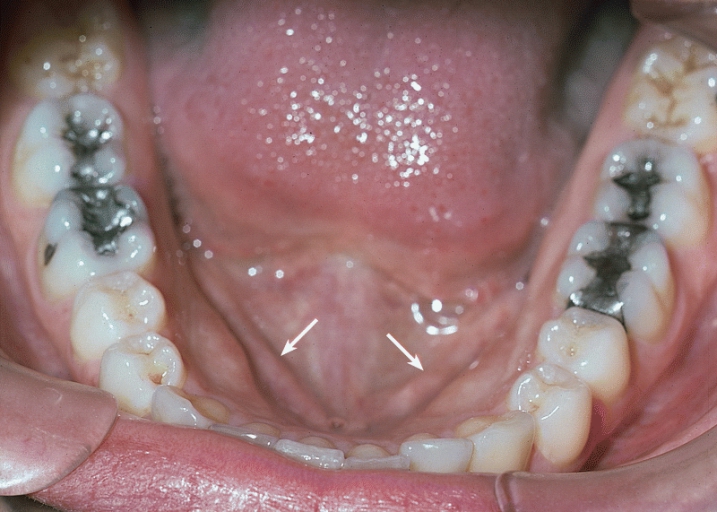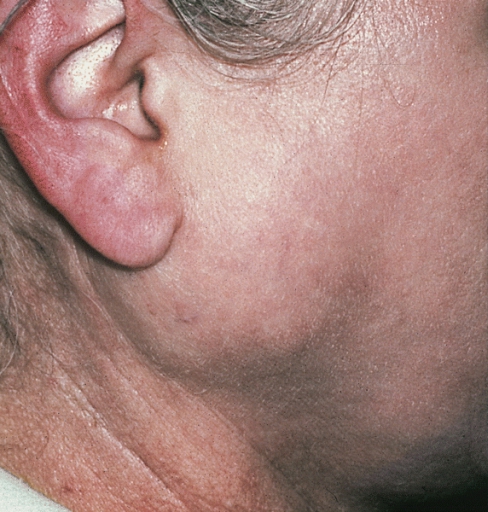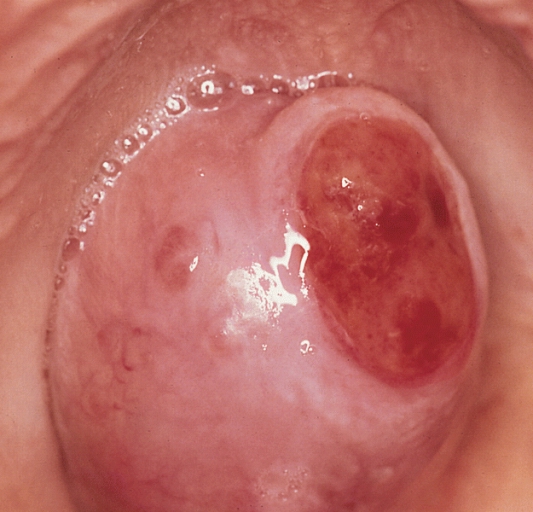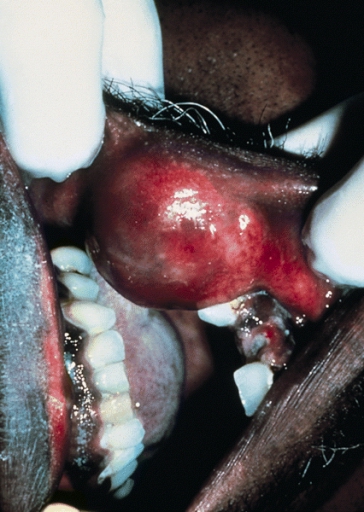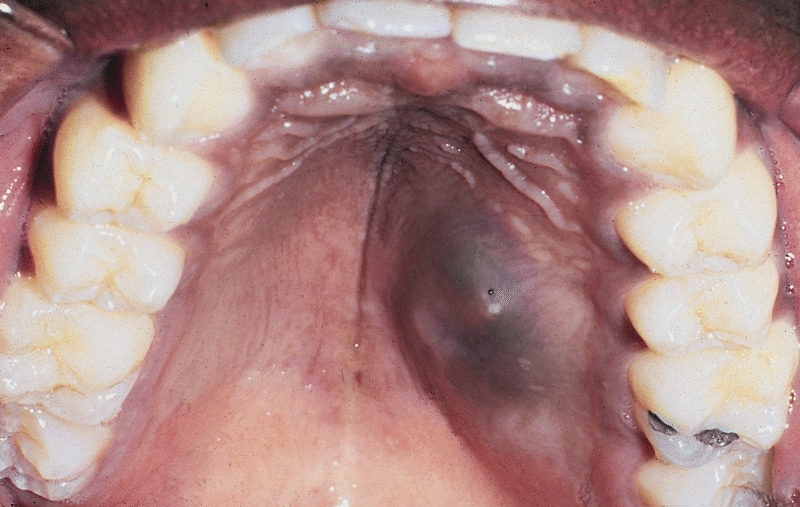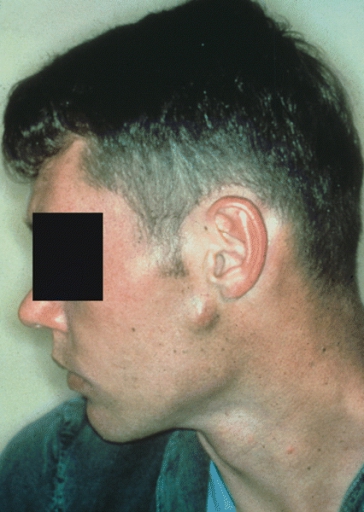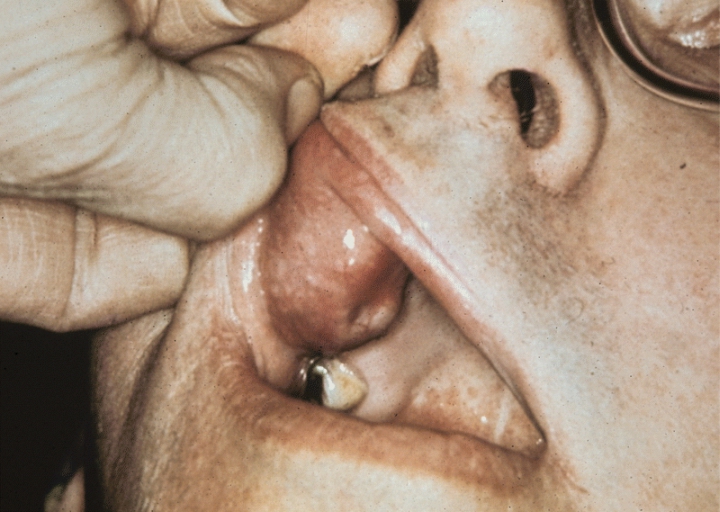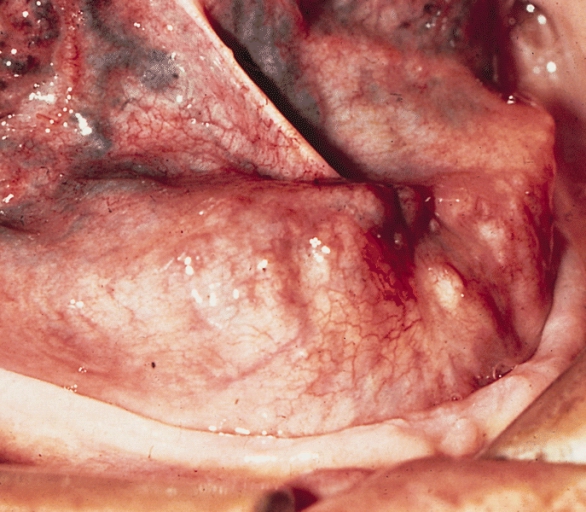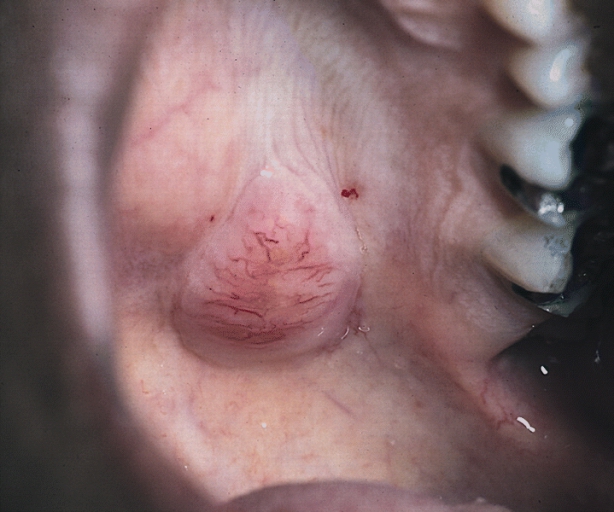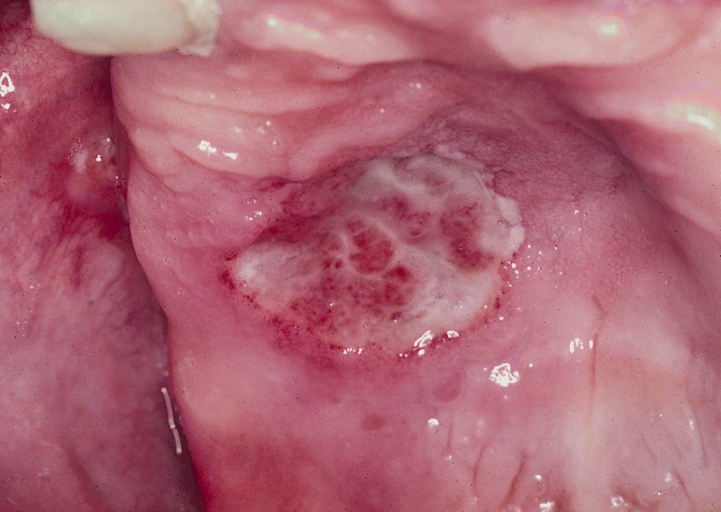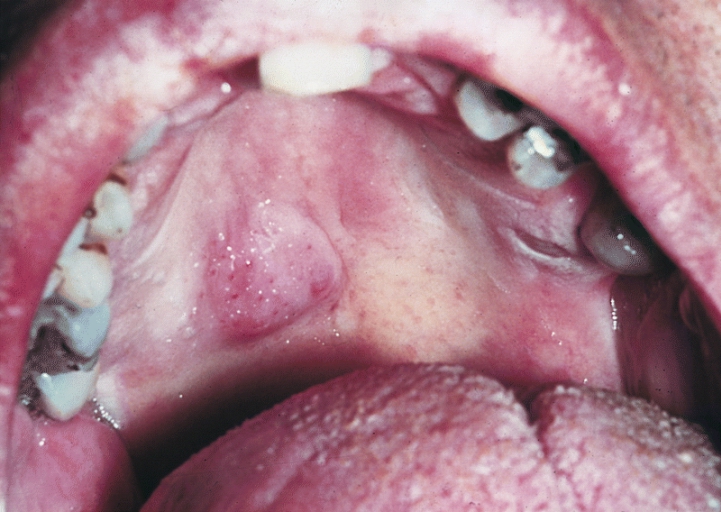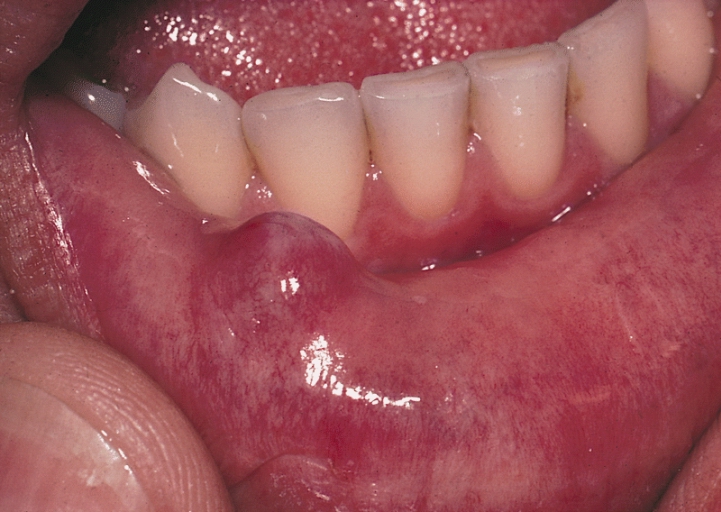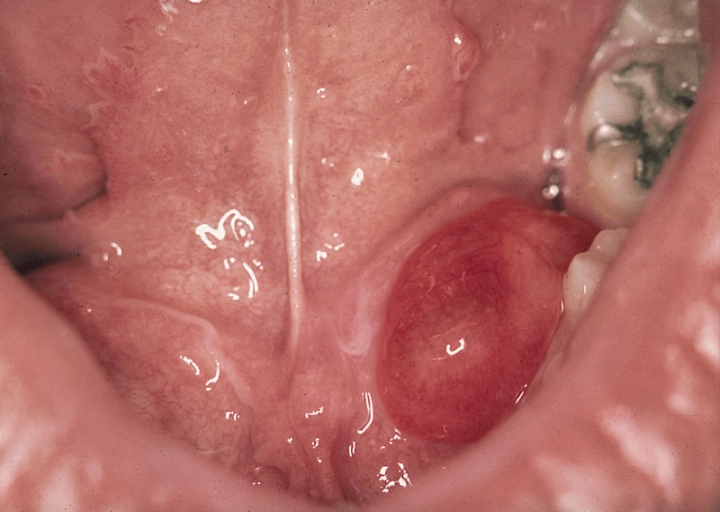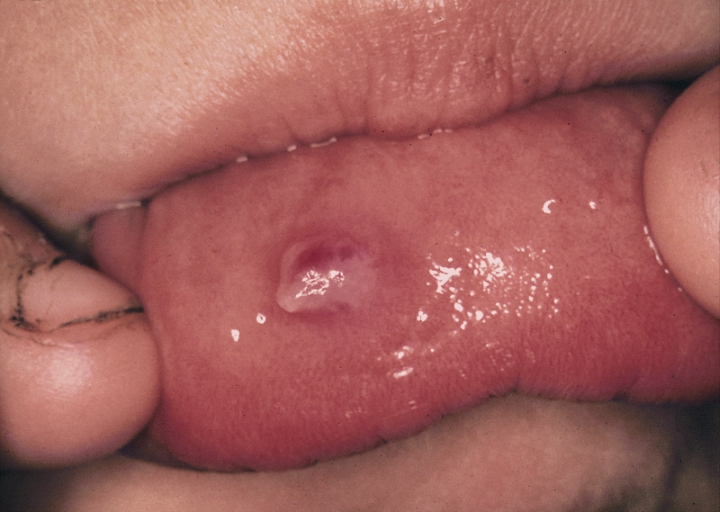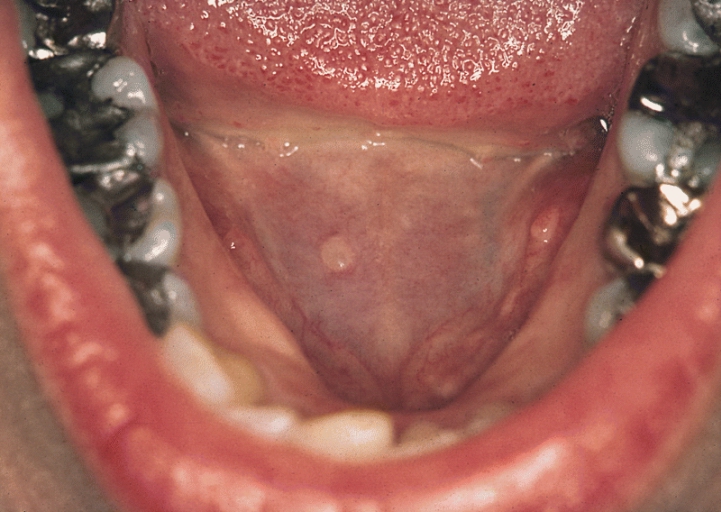Salivary gland enlargement
| Salivary gland enlargement | |
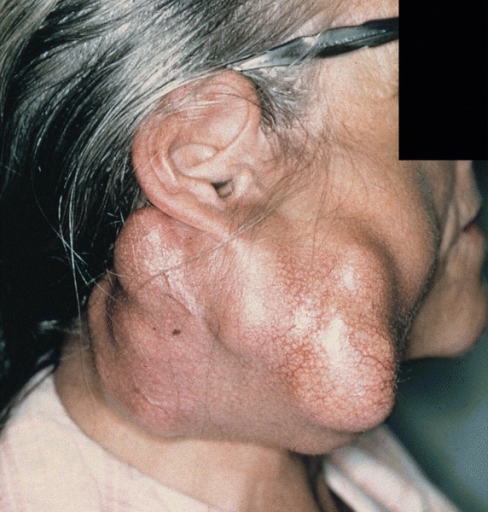 | |
|---|---|
| Salivary gland enlargement. Recurrent mixed tumor. Image courtesy of Professor Peter Anderson DVM PhD and published with permission © PEIR, University of Alabama at Birmingham, Department of Pathology |
Editor-In-Chief: C. Michael Gibson, M.S., M.D. [1]
Overview
Differential Diagnosis of Causes of Salivary gland enlargement
In Alphabetical Order. [1] [2]
- Acromegaly
- Amyloidosis
- Anorexia Nervosa
- Bacterial infection
- Chronic sialadenitis
- Cirrhosis
- CMV
- Coxsackie Virus
- EBV
- HIV
- Hyperlipidemia
- Mumps
- Salivary gland tumor
- Sarcoidosis
- Tuberculosis
Normal Salivary Glands
-
SALIVARY GLANDS: WHARTON'S DUCT: The right and left submandibular ducts (arrows) course anteriomedially in the floor of the mouth to openings at the lingual carunculae, which are only a few millimeters apart.
Pathological Findings
-
SALIVARY GLANDS: MIXED TUMOR OF PAROTID. The pre-auricular mass had enlarged to this size over a period of 5 years.(Courtesy of Dr. Charles E. Tomich, Indianapolis, IN.)
-
SALIVARY GLANDS: RECURRENT MIXED TUMOR. The characteristic multinodular growth of recurrent mixed tumor is obvious inthis parotid mass. (Courtesy of Dr. Lewis R. Eversole, Los Angeles, CA.)
-
SALIVARY GLANDS: MIXED TUMOR OF PALATE. Most mixed tumors involve only one side of the palate because there are few minor glands in the midline. In this case the tumor appears symmetrical on either side of the midline. Large intraoral tumors are susceptible to trauma-related ulceration, as illustrated here. (Courtesy of F. J.Kratochvil, Bethesda, MD.)
-
SALIVARY GLANDS: CANALICULAR ADENOMA. The upper lip is the site for over 70% of canalicular adenomas.
-
SALIVARY GLANDS: MUCOEPIDERMOID CARCINOMA OF PALATE. These tumors frequently are slightly raised, fluctuant, bluish discolorations of the palatal mucosa that are clinically thought to represent mucous escapereactions.
-
SALIVARY GLANDS: ACINIC CELL ADENOCARCINOMA: CLINICAL PRESENTATION: A 2.0-cm raised subcutaneous nodule just anterior to the lower portion of the ear is a common clinical presentation for acinic cell adenocarcinoma. The tumor is in the superficial lobe of the left parotid gland of this 24-year-old man.
-
SALIVARY GLANDS: ACINIC CELL ADENOCARCINOMA: CLINICAL PRESENTATION. The upper lip, or any other intra oral site, is an uncommon location for acinic cell adenocarcinoma.
-
SALIVARY GLANDS: ADENOID CYSTIC CARCINOMA. This sublingual gland tumor slowly enlarged to produce a large, lobulated mass in the anterior floor of the mouth. The oral mucosa is intact.
-
SALIVARY GLANDS: POLYMORPHOUS LOW-GRADE ADENOCARCINOMA. This tumor presented as a well-circumscribed, slow growing mass at the junction of the hard and soft palates. Pronounced telangiectasia of the overlying mucosa is evident. (Courtesy of Dr. Richard Canaan, Ocean Springs,MS.)
-
SALIVARY GLANDS: SJÖGREN'S SYNDROME Along with the symptoms of keratoconjunctivitis sicca and xerostomiathis, this woman has marked enlargement of the left parotid gland and slight enlargement of the right parotid gland, which are features of primary lesion.
-
SALIVARY GLANDS: NECROTIZING SIALOMETAPLASIA. A 2-to 3-cm unilateral ulcer of the hard palate that is slow to heal is a common clinical presentation for necrotizing sialometaplasia.
-
SALIVARY GLANDS: NECROTIZING SIALOMETAPLASIA. Swelling, as shown in this photograph of a palatal lesion, is a frequent initial clinical presentation. Many of the swellings subsequently ulcerate. (Courtesy of Dr. Ralph Correll, LosAngeles, CA.)
-
SALIVARY GLANDS: MUCOCELE. This extravasation type mucocele is a smooth-surfaced, dome-shaped nodule of the mucosa of the lower lip, the most common site for these lesions.
-
SALIVARY GLANDS: RANULA. This 2.5-cm ranula in the anterior floor of the mouth is not especially large, but it is larger than mucoceles that occur in most other sites.Ranulas are either extravasation type or retention cyst type mucoceles.
-
SALIVARY GLANDS: RUPTURED MUCOCELE. This mucocele of the lower lip has ruptured and collapsed due to trauma from lip biting.
-
SALIVARY GLANDS: SUPERFICIAL MUCOCELE. This mucocele in the floor of the mouth has a translucent appearance because the mucosa overlying it is very thin.
